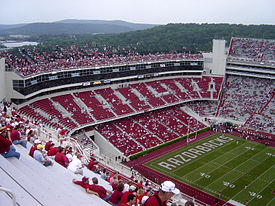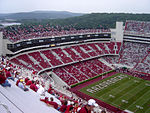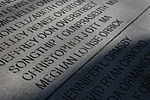- Donald W. Reynolds Razorback Stadium
-
Donald W. Reynolds Razorback Stadium 
Former names University Stadium (1938)
Bailey Stadium (1938–1941)
Razorback Stadium (1941–2001)Location N Stadium Dr and W Maple St, Fayetteville, AR 72701 Coordinates 36°4′5″N 94°10′44″W / 36.06806°N 94.17889°WCoordinates: 36°4′5″N 94°10′44″W / 36.06806°N 94.17889°W Broke ground 1937 Opened September 24, 1938[1] Renovated 2001 Expanded 1947, 1950, 1957, 1965, 1969, 1985, 2001 Owner University of Arkansas Operator University of Arkansas Surface SportsExe PowerBlade HP[2] Construction cost $492,000[3]
($7.67 million in 2011 dollars[4])
$106 million (renovation)Architect Heery International (renovation) Capacity 72,000 (expandable to 80,000) (2001-present)
51,000 (1985-2000)
42,678 (1969-1984)
26,400 (1957-1968)
21,200 (1950-1956)
16,000 (1947-1949)
13,500 (1938-1946)Executive Suites 132 Record attendance 76,808 (September 25, 2010)[5] Field dimensions 360 by 160 feet (110 × 49 m) Tenants Arkansas Razorbacks (NCAA) (1938–present) Donald W. Reynolds Razorback Stadium is an American football stadium in Fayetteville, Arkansas and serves as the home field of the University of Arkansas Razorbacks football team since its opening in 1938. The stadium was formerly known as Razorback Stadium since 1941 before being renamed in 2001 in honor of Donald W. Reynolds, an American businessman and philanthropist. The playing field in the stadium is named the Frank Broyles Field, honoring former Arkansas head football coach and athletic director Frank Broyles.[6]
Razorback Stadium increased the seating capacity from 51,000 to 72,000 (with an option to expand capacity to 80,000 with temporary bleacher seating) during the 2000-2001 renovations. The stadium also features a 30 by 107 feet SmartVision LED display, which was then the largest video board at any sports venue in the world.[7]
Contents
History
Before 1938, the Razorbacks played in a 300-seat stadium built in 1901 on land on top of "The Hill", which is now occupied by Mullins Library and the Fine Arts Center (in the "center" of campus). The new stadium cost approximately $492,000 and was funded by the Works Progress Administration, with the University of Arkansas only paying 22 percent of the contact.[8][9][10] The stadium opened for the 1938 football season as University Stadium, holding a capacity of 13,500 spectators. In the home opener for the Razorbacks, the Razorbacks defeated Oklahoma A&M by a score of 27–7 on September 24, 1938. The following week, Arkansas dedicated the stadium to then sitting Arkansas Governor Carl E. Bailey on October 3, 1938, changing the name of the stadium to Bailey Stadium. Following Governor Bailey's defeat in the 1940 gubernatorial election to Homer Martin Adkins, the stadium's name was changed in 1941 to Razorback Stadium.[11]
Athletic director Frank Broyles began searching for architects for the proposed $65 million stadium expansion and renovation in 1998, believing that the renovation was needed in order for the Razorbacks to compete in the Southeastern Conference at a consistent level.[12] Broyles hoped for a completion date of 2000 or 2001 and narrowed the search down to three architecture firms: Eisenman Architects of New York, Heery International of Atlanta and Rosser International of Atlanta.[9][10] Broyles awarded the renovation contract to Heery International with local support from the Wittenberg, DeLoney and Davidson architecture firm of Fayetteville.[13]
The renovation was partly funded by the Donald W. Reynolds Foundation, when the foundation donated $21 million in 1999 to help renovate the stadium.[14] What was then the largest LED display in a sports venue, the 30 by 107 foot screen produced by SmartVision was installed along with a new scoreboard at the northern end zone in 2000. The expansion was completed before the beginning of the 2001 football season, increasing the permanent seating capacity to 72,000 from its previous capacity of 51,000 seats. The Razorback Stadium was renamed Donald W. Reynolds Razorback Stadium in honor of the generosity by the Reynolds Foundation on September 8, 2001, where Arkansas lost to Tennessee by a score of 13–3.
On November 3, 2007, the date of the last Fayetteville home game of the 2007 football season, the playing field was dedicated and named in honor of outgoing athletic director Frank Broyles.[15]
Controversy
See also: War Memorial Stadium (Arkansas)Since 1948, home games were divided between two venues: Razorback Stadium and War Memorial Stadium in Little Rock, Arkansas. Athletic director Frank Broyles wanted to move all home games to Razorback Stadium to help pay off the $30 million bond that was to be used for expanding and renovating the stadium in 1999. Broyles pointed out that the expanded Razorback Stadium would increase revenue to $3 million per game compared to the $2 million per game for playing at War Memorial Stadium.[12][16] However, Little Rock investors did not like the idea of moving all home games to Fayetteville and countered with an offer to renovate and expand War Memorial Stadium to increase revenue. Also, Little Rock investor Warren Stephens threatened to discontinue his family's support ($150,000 in annual donations with an additional $1 million in annual support from his family's company Stephens Inc.) for the program if games were pulled from Little Rock.[12] After listening to both Chuck Neinas (Broyles' consultant on the issue) and Stephens in January 2000, the University of Arkansas Board of Trustees voted 9 to 1 to sign a compromised contract with the owners of War Memorial Stadium. The contract would keep at least two Razorbacks game, with one being a conference game, in Little Rock until the end of the 2014 season.[17] In 2008, the contract with War Memorial Stadium was extended through the 2016 football season by athletic director Jeff Long.[18]
Other uses
In 2010, Razorback Stadium was used for youth football when head football coach Bobby Petrino offered the Fayetteville chapter of the Boys and Girls Clubs of America use of the stadium during the Razorback's bye-week in the 2010 season.[19]
Gallery
References
- ^ http://www.arkansasrazorbacks.com/ViewArticle.dbml?DB_OEM_ID=6100&ATCLID=187018
- ^ "Arkansas selects turf for Razorback Stadium.". University of Arkansas Athletic Media Relations. 2009-06-02. http://www.arkansasrazorbacks.com/ViewArticle.dbml?DB_OEM_ID=6100&ATCLID=3745665. Retrieved 2009-06-04.
- ^ http://select.nytimes.com/gst/abstract.html?res=FA0B10F93B581A7A93CBA9178BD95F4C8385F9
- ^ Consumer Price Index (estimate) 1800–2008. Federal Reserve Bank of Minneapolis. Retrieved December 7, 2010.
- ^ Glier, Ray (2010-09-25). "Sloppy but Strong, Alabama Rallies". Associated Press (The New York Times). http://www.nytimes.com/2010/09/26/sports/ncaafootball/26arkansas.html. Retrieved 2010-12-29.
- ^ "Arkansas names football field after outgoing athletic director Frank Broyles". Associated Press. SportingNews. 2007-11-04. http://www.sportingnews.com/ncaa-football/story/2007-11-03/arkansas-names-football-field-after-outgoing-athletic-director-frank-broyles?story-topic-NCAAF=NBA. Retrieved 2010-12-29.
- ^ Kuhlenschmidt, Jack (2010-10-28). "Stadium Preview: Donald W. Reynolds Razorback Stadium". The Vanderbilt Hustler (InsideVandy). http://www.insidevandy.com/drupal/node/15269. Retrieved 2010-12-29.
- ^ Martin, Michael S. (2002). Chemical Engineering at the University of Arkansas: A Centennial History, 1902-2002. Fayetteville: University of Arkansas Press. ISBN 097134700X. http://books.google.com/books?id=VlXJIRMcSmAC&printsec=frontcover&source=gbs_ge_summary_r&cad=0#v=onepage&q&f=false.
- ^ a b "Firms line up for UA stadium project. (Razorback Stadium in Arkansas)". Arkansas Business (Entrepreneur). 1998-10-12. http://www.entrepreneur.com/tradejournals/article/21233084.html. Retrieved 2010-12-29.
- ^ a b "Best And Worst Of 1998". Arkansas Business (Arkansas Business). 1998-12-28.
- ^ Thompson, T.T. Tyler (2004). The University of Arkansas Razorback Band: A History, 1874-2004. Fayetteville: University of Arkansas Press. p. 57. ISBN 1557287791. http://books.google.com/books?id=vldxGLeYmUYC&printsec=frontcover&source=gbs_ge_summary_r&cad=0#v=onepage&q&f=false.
- ^ a b c Schroeder, George (2005). Hogs! The Story of Razorbacks Football. New York: Simon & Schuster. p. 207. ISBN 0743280520. http://books.google.com/books?id=3c5sVvB0ihQC&printsec=frontcover&source=gbs_ge_summary_r&cad=0#v=onepage&q&f=false.
- ^ Allen, Nate (1999-08-05). "Razorback Stadium going uptown". Log Cabin. http://thecabin.net/stories/080599/spo_0805990026.html. Retrieved 2010-12-29.
- ^ "$10 Million Grant From Donald W. Reynolds Foundation Brings New Life to Vol Walker Hall". University of Arkansas Relations. 2010-05-13.
- ^ "McFadden rushes for SEC-record 323 yards as Arkansas rolls". Associated Press (ESPN). 2007-11-03. http://scores.espn.go.com/ncf/recap?gameId=273070008. Retrieved 2010-12-29.
- ^ "Broyles' Power: Fierce or Fading?". Arkansas Business Publishing Group (Entrepreneur). 2000-07-24. http://www.entrepreneur.com/tradejournals/article/64153344.html. Retrieved 2010-12-29.
- ^ Schroeder, George (2005). Hogs! The Story of Razorbacks Football. New York: Simon & Schuster. p. 208. ISBN 0743280520. http://books.google.com/books?id=3c5sVvB0ihQC&printsec=frontcover&source=gbs_ge_summary_r&cad=0#v=onepage&q&f=false.
- ^ "Razorbacks sign two-year War Memorial Extension". 2008-08-23. http://thecabin.net/stories/082308/spo_0823080040.shtml. Retrieved 2010-11-25.
- ^ Bahn, Criss (2010-09-30). "Bahn: Petrino Doing 'Awesome' Thing Offering Up Razorback Stadium for Boys and Girls Club". Arkansas Sports 360. http://www.arkansassports360.com/20202/bahn-petrino-doing-awesome-thing-offering-up-razorback-stadium-for-boys-girls-club. Retrieved 2010-12-29.
External links
- Arkansas Razorbacks Official Site Donald W. Reynolds Razorback Stadium Overview
- Google Maps Satellite Image/Map of Donald W. Reynolds
Arkansas Razorbacks football Stadia Donald W. Reynolds Razorback Stadium • War Memorial Stadium • The Hill (former)
Players Coaches Futrall • Wilson • Searles • Thomas • McDaniel • Brown • Longman • Bezdek • Pickering • McConnell • Paine • Craig • McLaren • Schmidt • Thomsen • Cole • Tomlin • Rose • Barnhill • Douglas • Wyatt • Mitchell • Broyles • Holtz • Hatfield • Crowe • Kines (interim) • Ford • Nutt • Herring (interim) • PetrinoCulture Rivalries Texas • Texas A&M • LSU • Ole MissSeasons 1894 • 1895 • 1896 • 1897 • 1898 • 1899 •
1900 • 1901 • 1902 • 1903 • 1904 • 1905 • 1906 • 1907 • 1908 • 1909 •
1910 • 1911 • 1912 • 1913 • 1914 • 1915 • 1916 • 1917 • 1918 • 1919 •
1920 • 1921 • 1922 • 1923 • 1924 • 1925 • 1926 • 1927 • 1928 • 1929 •
1930 • 1931 • 1932 • 1933 • 1934 • 1935 • 1936 • 1937 • 1938 • 1939 •
1940 • 1941 • 1942 • 1943 • 1944 • 1945 • 1946 • 1947 • 1948 • 1949 •
1950 • 1951 • 1952 • 1953 • 1954 • 1955 • 1956 • 1957 • 1958 • 1959 •
1960 • 1961 • 1962 • 1963 • 1964 • 1965 • 1966 • 1967 • 1968 • 1969 •
1970 • 1971 • 1972 • 1973 • 1974 • 1975 • 1976 • 1977 • 1978 • 1979 •
1980 • 1981 • 1982 • 1983 • 1984 • 1985 • 1986 • 1987 • 1988 • 1989 •
1990 • 1991 • 1992 • 1993 • 1994 • 1995 • 1996 • 1997 • 1998 • 1999 •
2000 • 2001 • 2002 • 2003 • 2004 • 2005 • 2006 • 2007 • 2008 • 2009 •
2010 • 2011
National Championship: 1964
Conference Championships: 1936 • 1946 • 1954 • 1959 • 1960 • 1961 • 1964 • 1965 • 1968 • 1975 • 1979 • 1988 • 1989Conferences Southwest Conference (SWC) (1915–1991) • Southeastern Conference (SEC) (1992–Present)Football stadiums of the Southeastern Conference Eastern Division Western Division Bryant–Denny Stadium (Alabama) • Razorback Stadium (Arkansas, primary) • War Memorial Stadium (Arkansas, secondary) • Jordan–Hare Stadium (Auburn) • Tiger Stadium (LSU) • Davis Wade Stadium (Mississippi State) • Vaught–Hemingway Stadium (Ole Miss)
Future College football venues in Arkansas Division I
FBSSEC Donald W. Reynolds Razorback Stadium & War Memorial Stadium (Arkansas)
Sun Belt ASU Stadium (Arkansas State)
Division I
FCSSouthland SWAC Division II Gulf South Convoy Leslie-Cotton Boll Stadium (Arkansas–Monticello) • Buerkle Field (Arkansas Tech) • First Security Stadium (Harding) • Carpenter-Haygood Stadium (Henderson State) • A. U. Williams Field (Ouachita Baptist) • Wilkins Stadium (Southern Arkansas)
Categories:- Arkansas Razorbacks football venues
- American football venues in Arkansas
- Buildings and structures in Fayetteville, Arkansas
- Visitor attractions in Washington County, Arkansas
Wikimedia Foundation. 2010.







